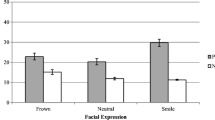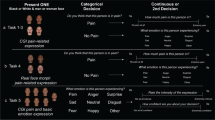Abstract
Objective
Patients presenting for corrective facial surgery may have ideals that are not congruent with their surgeon’s expectations for surgical outcomes. To identify and reduce disparities in expectations, the Facial Appearance as Core Expression Scale (FACES) was developed to assess the extent to which individuals identify their own faces as representing their ideal self.
Method
In Study 1, 504 healthy young adult participants answered online questions about their own faces. In Study 2, 165 participants rated their own faces, digitally manipulated images of four patients before and after surgery, and two digitally averaged benchmark images.
Results
In Study 1, the final FACES instrument had seven items and was highly reliable across genders and races. Study 2 replicated reliability findings. The before surgery and after surgery pictures yielded significant improvements in ratings, suggesting scale validity.
Conclusions
The FACES consists of 14 items including a benchmark image to detect unusual responding. Results indicate the measure is reliable and sensitive to perceptions of surgical changes to faces. While the scale needs to be validated in a clinical sample, the measure may help identify patients with atypical ideal expectations for their face and may be used to quantify surgical outcomes.


Similar content being viewed by others
References
Plastic surgery statistics (2022) American society of plastic surgeons. https://www.plasticsurgery.org/news/plastic-surgery-statistics?sub=2019%2BPlastic%2BSurgery%2BStatistics. Published 2020.
Flanary CM, Barnwell GM, Alexander JM (1985) Patient perceptions of orthognathic surgery. Am J Orthod 88(2):137–145. https://doi.org/10.1016/0002-9416(85)90238-6
Garvill J, Garvill H, Kahnberg K-E, Lundgren S (1992) Psychological factors in orthognathic surgery. J Cranio-Maxillofacial Surg 20(1):28–33. https://doi.org/10.1016/s1010-5182(05)80193-3
Reips U-D (2002) Standards for internet-based experimenting. Exp Psychol (Formerly Zeitschrift für Experimentelle Psychologie) 49(4):243–256. https://doi.org/10.1027//1618-3169.49.4.243
Herruer JM, Prins JB, van Heerbeek N, Verhage-Damen GW, Ingels KJ (2015) Negative predictors for satisfaction in patients seeking facial cosmetic surgery. Plast Reconstr Surg 135(6):1596–1605. https://doi.org/10.1097/prs.0000000000001264
Honigman RJ, Phillips KA, Castle DJ (2004) A review of psychosocial outcomes for patients seeking cosmetic surgery. Plast Reconstr Surg 113(4):1229–1237. https://doi.org/10.1097/01.prs.0000110214.88868.ca
Juggins KJ, Nixon F, Cunningham SJ (2005) Patient- and clinician-perceived need for orthognathic surgery. Am J Orthod Dentofac Orthop 128(6):697–702. https://doi.org/10.1016/j.ajodo.2004.09.022
Perrett DI, May KA, Yoshikawa S (1994) Facial shape and judgements of female attractiveness. Nature 368(6468):239–242. https://doi.org/10.1038/368239a0
Laufer D, Glick D, Gutman D, Sharon A (1976) Patient motivation and response to surgical correction of prognathism. Oral Surgery, Oral Medicine, Oral Pathology 41(3):309–313. https://doi.org/10.1016/0030-4220(76)90143-2
DeBruine LM, Jones BC, Smith FG, Little AC (2010) Are attractive men’s faces masculine or feminine? The importance of controlling confounds in face stimuli. J Exp Psychol Hum Percept Perform 36(3):751–758. https://doi.org/10.1037/a0016457
Posnick JC, Kinard BE (2019) Orthognathic surgery has a significant positive effect on perceived personality traits and perceived emotional facial expressions in subjects with primary mandibular deficiency. Journal of Craniofacial Surgery 30(8):2337–2340. https://doi.org/10.1097/scs.0000000000005915
Wolfe CR, Dandignac M, Sullivan R, Moleski T, Reyna VF (2019) Automatic evaluation of cancer treatment texts for gist inferences and comprehension. Med Decis Making 39(8):939–949. https://doi.org/10.1177/0272989x19874316
Wengle H-P (1986) The Psychology of Cosmetic Surgery: A critical overview of the literature 1960–1982—part I. Ann Plast Surg 16(5):435–443. https://doi.org/10.1097/00000637-198605000-00011
Wolfe CR (2017) Twenty Years of internet-based research at SCIP: A discussion of surviving concepts and New Methodologies. Behav Res Methods 49(5):1615–1620. https://doi.org/10.3758/s13428-017-0858-x
Acknowledgments
We thank the following Miami University undergraduate students who assisted with data collection: Alyssa Conyers, Natalie Goldfein-Killilea, Aiyana Green, Vasanthi Kalidindi, Tatum Moleski, Jordan Oldham, Sheysel Sanchez, Rachel Sullivan, Chase Tirey, Eleni Vidalis, Ellie Wallace, Margo Weber, and Zhenyang Yu.
Author information
Authors and Affiliations
Contributions
All persons who meet authorship criteria are listed as authors, and all authors certify that they have participated sufficiently in the work to take public responsibility for the content, including participation in the concept, design, analysis, writing, or revision of the manuscript. Furthermore, each author certifies that this material or similar material has not been and will not be submitted to or published in any other publication before its appearance in the Journal of Maxillofacial and Oral Surgery. All persons who have made substantial contributions to the work reported in the manuscript (e.g., technical help, writing and editing assistance, general support), but who do not meet the criteria for authorship, are named in the Acknowledgements and have given us their written permission to be named. If we have not included an Acknowledgements, then that indicates that we have not received substantial contributions from non-authors.
Corresponding author
Ethics declarations
Conflict of interest
We do not have any conflicts of interest to report.
Additional information
Publisher's Note
Springer Nature remains neutral with regard to jurisdictional claims in published maps and institutional affiliations.
Rights and permissions
Springer Nature or its licensor holds exclusive rights to this article under a publishing agreement with the author(s) or other rightsholder(s); author self-archiving of the accepted manuscript version of this article is solely governed by the terms of such publishing agreement and applicable law.
About this article
Cite this article
Wolfe, C.R., Krishnan, D.G., Ortiz, S.N. et al. Facial Appearance as Core Expression Scale: Benchmarks and Properties. J. Maxillofac. Oral Surg. 22, 873–878 (2023). https://doi.org/10.1007/s12663-022-01802-6
Received:
Accepted:
Published:
Issue Date:
DOI: https://doi.org/10.1007/s12663-022-01802-6




